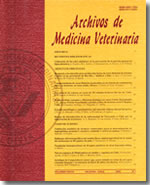Evaluation of two pigmentation strategies in coho salmon (Oncorhynchus kisutch)
Main Article Content
Abstract
The objective of this study was to evaluate the effects of sex and two periods of feeding with a diet that included astaxanthin on productive performance, color and pigmentation of coho salmon (Oncorhynchus kisutch) at harvest. The trial was carried out in sea cages (5x5x10 m). A total of 1368 coho salmon were assigned to 4 cages with 342 salmons in each, two cages for the experimental group (80 ppm of astaxanthin for 105 days) and two for the control group (80 ppm of astaxanthin for 55 days). The variables registered were weight, feed efficiency, condition factor, carcass yield, hepatosomatic and gonadosomatic indexes, color and pigmentation of steak and fillet. The color was evaluated with Roche® Color chart and Salmo-Fan and Minolta Chroma Meter. The pigment level in the steak and fillet was determined with NIR. The productive performance was quite similar in both treatments, with a high gonadosomatic index. The correlations determined were low with different levels of significance. The color and pigmentation of steaks and fillets were greater (P 0.05) in the control treatment that was fed for 105 days with pigmented diet. The males were more colored and pigmented (P 0.05) than females in steaks and fillets. The fillets of both treatments registered the value of 15 in Roche® Color chart that was the commercial minimum for this cut, but those from the experimental group were below the minimum of 30 when the assessment was made with the Roche® Salmo-Fan. According to the conditions of this study, a feeding period of 53 days with a pigmented diet was not appropriate to obtain a commercial color in coho salmons fillets, when the comparison was made with the more sophisticated Salmo-Fan method.

